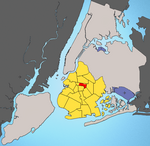George W. Wingate High School
George W. Wingate High School is a defunct comprehensive high school in the Prospect Lefferts Gardens and Wingate neighborhoods of Brooklyn, New York City. It opened in 1956 and was closed down in June 2006 due to poor academic performance. The school was then divided into four small schools. The school was named for George Wood Wingate, an officer in the Union Army during the American Civil War. Wingate was the founder of the Public School Athletic League in New York City. The campus now houses four new small schools under the New Visions for Public Schools initiative of the New York City Department of Education (NYCDOE). There are the International Arts Business School, The School for Human Rights, The School for Democracy and Leadership and the High School for Public Service: Heroes of Tomorrow. The high school's sports teams were known as the 'Generals', for George Wingate's rank in the New York National Guard.
Excerpt from the Wikipedia article George W. Wingate High School (License: CC BY-SA 3.0, Authors).George W. Wingate High School
Kingston Avenue, New York Brooklyn
Geographical coordinates (GPS) Address Phone number Website Nearby Places Show on map
Geographical coordinates (GPS)
| Latitude | Longitude |
|---|---|
| N 40.6586 ° | E -73.944 ° |
Address
High School for Public Service
Kingston Avenue 600
11203 New York, Brooklyn
New York, United States
Open on Google Maps





